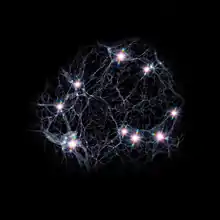
The Giant GRB Ring is a ring of 9 gamma-ray bursts (GRBs) that may be associated with one of the largest known cosmic structures.[1] It was discovered in July 2015[2] by a team of Hungarian and American astronomers led by L.G. Balazs while analyzing data from different gamma-ray and X-ray telescopes, in particular the Swift Spacecraft.[2]
The ring of GRBs lies at a distance of about 2.8 gigaparsecs (9.1 billion light years) from Earth at the redshift between 0.78 and 0.86[2] and measures about 1.72 gigaparsecs (5.6 billion light years) in diameter,[2] making it one of the largest structures known.[3]
Typically, the distribution of GRBs in the universe appears in the sets of less than the 2σ distribution, or with fewer than two GRBs in the average data of the point-radius system. Thus, such a concentration as this appears extremely unlikely, given accepted theoretical models. Proposals include the existence of a giant supergalactic structure. This would be an extremely huge structure of the universe, with a mean size of about 5.6 billion light years. Such a supercluster can explain the significant distribution of GRBs because of its tie to star formation. If such a structure did exist, it would be one of the largest structures of the observable universe.[4]
Discovery
In early July 2015, after the discovery of the Hercules–Corona Borealis Great Wall, I. Horvath, J. Hakkila and Z. Bagoly, among others, conducted a further detailed analysis of the spatial distribution of GRBs within the distant universe. Provided by more than 15 years of data from the Swift Gamma-Ray Burst Mission, amongst other ground-based telescopes, they assessed the data to see if any more structures can be seen using the method of GRB correlation. They noticed a significant clustering of GRBs within z = 0.78–0.86, with nine GRBs concentrated in that region of 43 by 30 degrees of the sky.[5] With further tests and analyses of the clustering, they found out that the sample had a higher concentration than the expected normal level, indication of a massive galactic structure within the vicinity.[2]
Characteristics
The authors list the following characteristics for the 9 GRBs in the ring (l and b are standard Sun-referenced galactic coordinates).[2]
| GRB ID | Redshift | Distance (Mpc) | l (deg) | b (deg) |
|---|---|---|---|---|
| 040924 | 0.859 | 2866 | 149.05 | −42.52 |
| 101225A | 0.847 | 2836 | 114.45 | −17.20 |
| 080710 | 0.845 | 2831 | 118.43 | −42.96 |
| 050824 | 0.828 | 2786 | 123.46 | −39.99 |
| 071112C | 0.823 | 2772 | 150.37 | −28.43 |
| 051022 | 0.809 | 2736 | 106.53 | −41.28 |
| 100816A | 0.804 | 2723 | 101.39 | −32.53 |
| 120729A | 0.800 | 2712 | 123.85 | −12.65 |
| 060202 | 0.785 | 2672 | 142.92 | −20.54 |
It is approximately 9.1 billion light years from Earth and about 5.6 billion light years across.[6]
See also
References
- ↑ "Giant Mystery Ring of Galaxies Should Not Exist". Archived from the original on 2015-10-28. Retrieved 2018-12-02.
- 1 2 3 4 5 6 Balazs, L.G.; Bagoly, Z.; Hakkila, J.E.; Horvath, I.; Kobori, J.; Racz, I.I.; Toth, L.V. (2015-08-05). "A giant ring-like structure at 0.78 < z < 0.86 displayed by GRBs". Monthly Notices of the Royal Astronomical Society. 452 (3): 2236. arXiv:1507.00675. Bibcode:2015MNRAS.452.2236B. doi:10.1093/mnras/stv1421.
- ↑ Robert Massey: 5 billion light years across: the largest feature in the universe. Royal Astronomical Society press release
- ↑ Five billion light years across: The largest feature in the universe
- ↑ Astronomers Discover Ring-Like Structure 5.6 Billion Light-Years Across
- ↑ The discovery.com article.
- Balázs, L. G.; Rejtő, L.; Tusnády, G. (21 January 2018). "Some statistical remarks on the giant GRB ring". Monthly Notices of the Royal Astronomical Society. 473 (3): 3169–3179. arXiv:1710.01621. Bibcode:2018MNRAS.473.3169B. doi:10.1093/mnras/stx2550.
- Pinter, S. (10 September 2018). "Multi‐messenger studies of γ‐ray bursts and their cosmic environment". Astronomische Nachrichten. 339 (5): 336–340. Bibcode:2018AN....339..336P. doi:10.1002/asna.201813501.